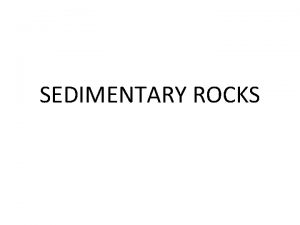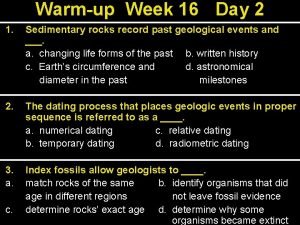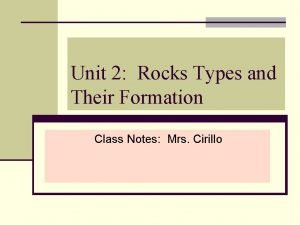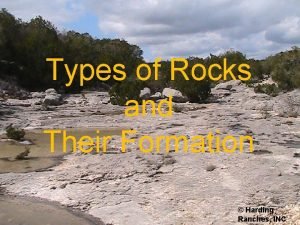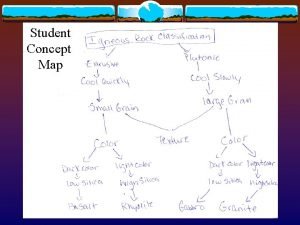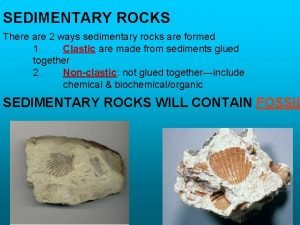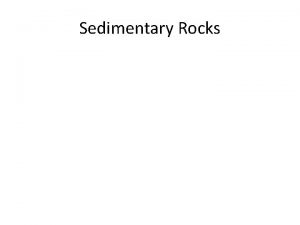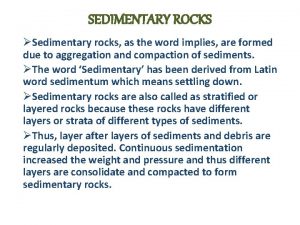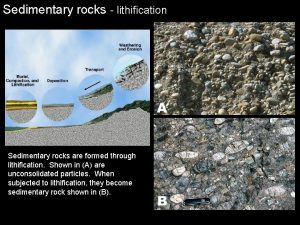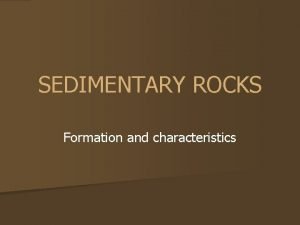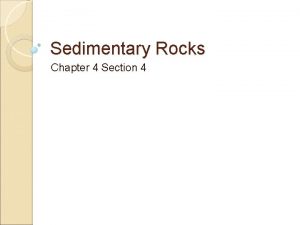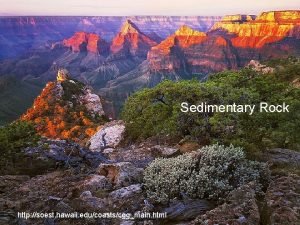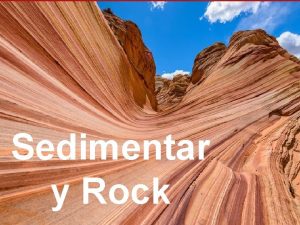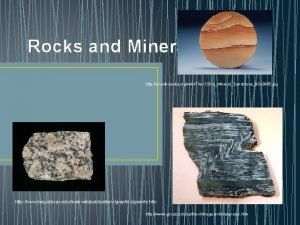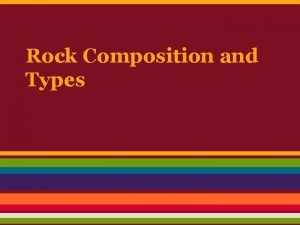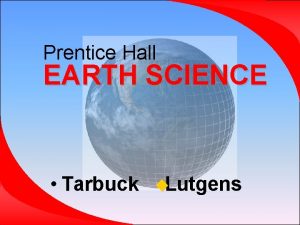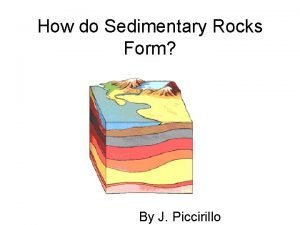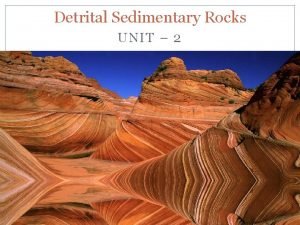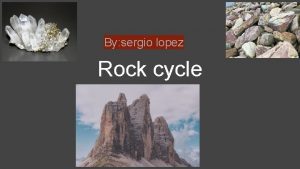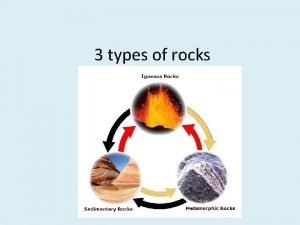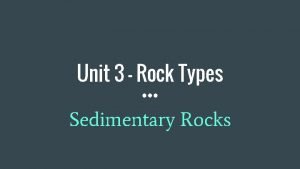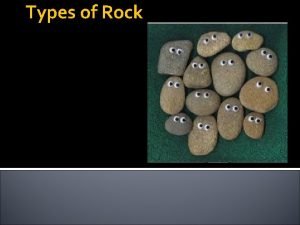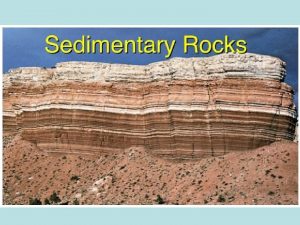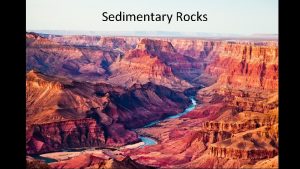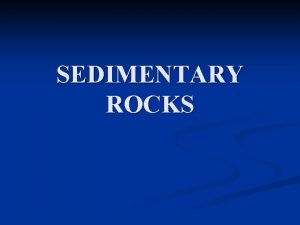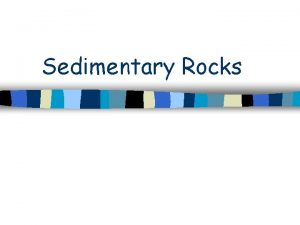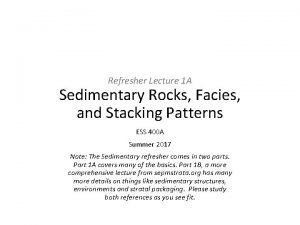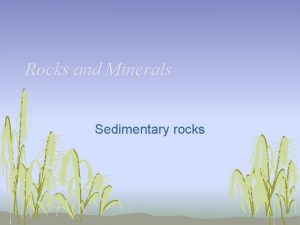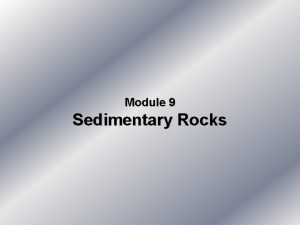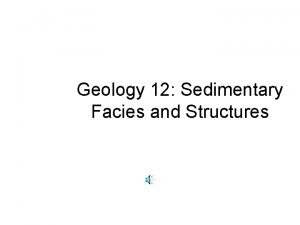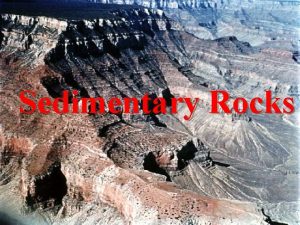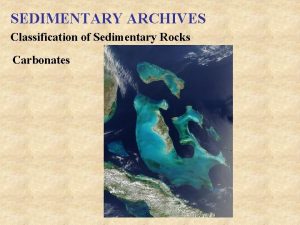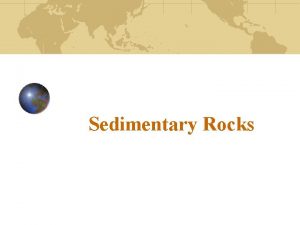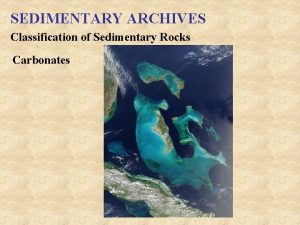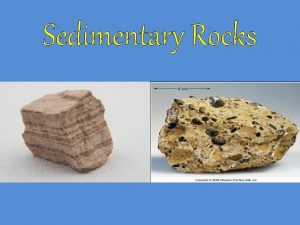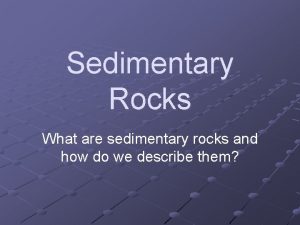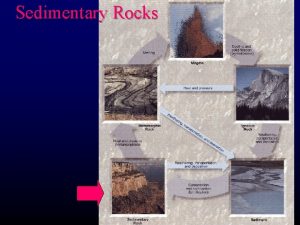Refresher Lecture 1 A Sedimentary Rocks Facies and





































- Slides: 37

Refresher Lecture 1 A Sedimentary Rocks, Facies, and Stacking Patterns ESS 400 A Summer 2020 Note: The Sedimentary refresher comes in two parts. Part 1 A covers many of the basics. Part 1 B, a more comprehensive lecture from sepmstrata. org has many more details on things like sedimentary structures, environments and stratal packaging. Please study both references as you see fit.

Outline • Basic Classification Schemes • Texture and Composition • Clastic vs carbonate vs chemical • Grain size, sorting, rounding, matrix • Depositional Environments and Facies • • Sedimentary structures Fossils and trace fossils Clastic environment examples Carbonate environment examples • Extra materials

Classification of Rocks Examples ?

Classification of Rocks

Four fundamental components of sedimentary rocks

composition of sedimentary rocks • Biogenic and chemical sediments? • Clastic? • • • Quartz Feldspar Phyllosilicates (micas, clays) Heavy minerals (zircon, rutile, titanite, etc. ) Lithics

Clastic Sediment and Rock Naming Conventions

Describing sedimentary rocks • Texture • • Grain size Rounding Sorting Composition • Structure (how grains are organized) • Bedding (massive, planar, trough x) • Grading (inverse, normal) • Bioturbation

Classification of clastic: grain size

Classification of clastic: rounding & sorting

Classification of clastic: composition “Mature” “Immature” (Granitic source) (Volcanic-sed. -metamorphic source)

Arenites vs. Wackes

Clastic texture: summary

Sedimentary structures • Sedimentary structures are features found within the sedimentary section, and/or between, bedding plane surfaces subdividing that section • Related to scale and hierarchy of features they occur in, whether in sediments that have confined (as in a channel) or unconfined settings (as on a shelf), & associated but similar sized structures • Sedimentary structures provide critical versus general clues to depositional setting • There are MANY kinds of sedimentary structures. See Refresher 1 B for examples of many of these.



Fossils and trace fossils • Fossils are found in many sedimentary rocks, and can be diagnostic of water depth, age of the strata and aerobic conditions in the water column. • Trace fossils are burrows, tracks, etc that were created by an organism which itself was not preserved. Ichnology is the study of trace fossils. • Fossils and trace fossils should be included in rock descriptions if they are present. • See Refresher 1 B for examples of some of these.

Carbonate Sedimentary Rocks

Sedimentary Rock Descriptors

Summary Interpretation | Description Descriptive questions for any outcrop • • • Rock type: clastic, carbonate, or chemical Detailed rock type: e. g. conglomerate, sandstone, or mudstone Texture: grain size, rounding, sorting, arenite vs. wacke Composition: minerals and lithics (later in week: QFL) Sedimentary structures: e. g. cross beds, planar beds, massive Biota: i. e. macrofossils, microfossils, trace fossils Other: color, weathering characteristics, level of induration/cementation Bedding: e. g. tabular, lenticular, sharp-based, graded, thinly bedded, etc. Vertical and lateral stacking: e. g. fining upward, coarsening upward, etc Depositional Environments, Facies, and Basin Type • • • Marine vs. non-marine (rock type, fossils, sed structures) Proximal vs. distal from source (texture) Shallow water vs. deep water (evidence for waves, tides, burrowing, etc. ) Transgressive vs. regressive (observe vertically adjacent units) Basin type (QFL, thickness patterns, detrital zircons, relationship to structures)

Skagit River, WA

Death Valley, CA Depositional system Closed basin What about lacustrine limestone? PC: Marli Miller

Extra Information • Example abstract with sed rock description and interpretation • Example stratigraphic columns • Depositional environments • Sedimentary stacking, sequence stratigraphy

Written descriptions of sedimentary rocks – an excellent example from a recent publication* The Palm Spring Formation consists of lower and upper members separated by a widespread angular unconformity (Figs. 4, 6 B, 8 E). The unconformity marks the boundary between regionally extensive and relatively uniform facies of the lower member, and highly variable localized facies of the upper member in the central Mecca Hills. The lower member of the Palm Spring Formation is 340 m thick in lower Painted Canyon where it conformably and gradationally overlies the Mecca Formation on the SW limb of Mecca Anticline (Figs. 3, 4, 6 B). It consists of tabular, uniformly bedded couplets of grus-rich, cross-bedded pebbly sandstone with plutonic and gneissic composition that fine up into biotite-rich ripple cross-laminated green siltstone and fine-grained sandstone to siltstone (Table 1, Fig. 7 B). Individual beds are laterally continuous with sharp boundaries that are traceable for several kilometers along strike, typically with little change in facies. Paleocurrent indicators suggest SE-directed transport (Fig. 6 B). The lithofacies assemblage and stratal architecture of the lower member in the central Mecca Hills is similar to that seen in the Indio Hills 25 km to the northwest, providing evidence for its regional extent. Exceptions are observed in Eagle Canyon where the lower member consists of poorly sorted cobble to boulder conglomerate (Table 1), and in the southeast part of the study area near Hidden Spring Wash (Fig. 2)where similar coarse facies were previously documented (Chang et al. , 1987; Boley et al. , 1994). The laterally extensive architecture and uniform facies of the lower member suggest deposition in a fluvial system composed of a migrating main channel or multiple channels (cross-bedded sandstone) and adjacent overbank floodplain (ripple cross-laminated green siltstone) that occupied a broad basin floor. The unconfined lateral migration of river channels created tabular-bedded fluvial architecture (e. g. , Miall, 1985; Hampton and Horton, 2007). Felsic-plutonic and gneissic clast compositions, and SE-directed paleocurrents suggest that the lower member was deposited in a large river system that flowed SE down the paleo-Coachella Valley into the Salton Trough, with sediment sources mainly in * Mc. Nabb, J. C. , et al. , Stratigraphic record of Pliocene-Pleistocene basin evolution and deformation within the Southern the Cottonwood and Little San Bernardino Mountains. Localized coarse facies of the San Andreas Zone, Mecca Hil. . . , Tectonophysics (2017), lower member likely Fault were deposited in proximal basin-margin alluvial fans. http: //dx. doi. org/10. 1016/j. tecto. 2017. 03. 021 Intro, brief generalization Detailed OBSERVATIONS. Places in regional context. Detailed INTERPRETATIONS.

Stratigraphic column examples

Stratigraphic column examples

Clastic depositional environments Wave-dominated shoreline example* (*see Refresher 1 B for additional clastic environments)

Carbonate depositional environments Barrier reef example* (*see Refresher 1 B for additional examples)

Sand Provenance (QFL Diagrams) The proportion of Qtz, Feldspar and Lithics in a sandstone will generally reflect the nature of the source area that flanked the sedimentary basin at the time of deposition.

A Simple Evolutionary Sedimentary Rock Model

Basic stacking, transgressions and regressions Transgression (sediments “retrograde”) Regression (sediments “prograde”)

Cyclicity and parasequence stacking

Real example of parasequence stacking

Stratigraphic correlation between outcrop measured sections • Parasequence boundaries represent chronostratigraphic (i. e. time-synchronous) surfaces • Facies and environment interpretations are based on sedimentary structures, textures, and biota • Note that within any parasequence, more proximal facies grade to more distal facies from updip (west/left) to downdip (east/right) in the basin

Sea level, sediment supply, subsidence

Sequence stratigraphy (Sepmstrata. org)

Sequence and chronostratigraphy Vertical axis is Time
 Igneous vs sedimentary or metamorphic
Igneous vs sedimentary or metamorphic Igneous rocks metamorphic rocks and sedimentary rocks
Igneous rocks metamorphic rocks and sedimentary rocks Sedimentary and metamorphic rocks section 6.1
Sedimentary and metamorphic rocks section 6.1 Concept map of rock formation
Concept map of rock formation Detrital
Detrital How are sedimentary rocks
How are sedimentary rocks Sedimentary rocks record past geological events and ____.
Sedimentary rocks record past geological events and ____. Facies etilica
Facies etilica Sedimentary weathering
Sedimentary weathering Esrt sedimentary rocks
Esrt sedimentary rocks Rock identification
Rock identification Igneous rocks concept map
Igneous rocks concept map Clastic sedimentary rocks
Clastic sedimentary rocks Characteristics of sedimentary rocks
Characteristics of sedimentary rocks Define bioclastic
Define bioclastic Characteristics of sedimentary rocks
Characteristics of sedimentary rocks What are sedimentary rocks
What are sedimentary rocks In sedimentary rocks lithification includes
In sedimentary rocks lithification includes Features of sedimentary rocks
Features of sedimentary rocks Sedimentary igneous rocks
Sedimentary igneous rocks How is chert formed
How is chert formed Sedimentary rocks examples
Sedimentary rocks examples What kind of sedimentary rock is coal
What kind of sedimentary rock is coal Facts on sedimentary rocks
Facts on sedimentary rocks Metamorphic rocks characteristics
Metamorphic rocks characteristics Sedimentary rocks characteristics
Sedimentary rocks characteristics Classify sedimentary rocks
Classify sedimentary rocks Formation of sedimentary rocks leaving cert
Formation of sedimentary rocks leaving cert Esrt sedimentary rocks
Esrt sedimentary rocks A process that squeezes or compacts sediments
A process that squeezes or compacts sediments Detrial sedimentary rocks
Detrial sedimentary rocks Characteristics of sedimentary rocks
Characteristics of sedimentary rocks Magma facts
Magma facts 3 types of rocks
3 types of rocks Biochemical sedimentary rocks
Biochemical sedimentary rocks Coarse grained rocks examples
Coarse grained rocks examples Types of sedimentary rocks
Types of sedimentary rocks Is coal clastic organic or chemical
Is coal clastic organic or chemical




